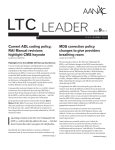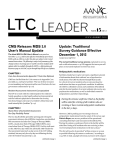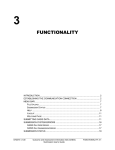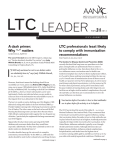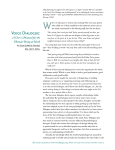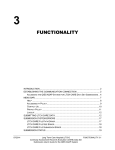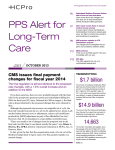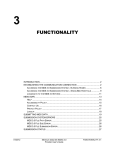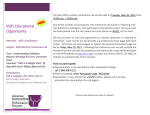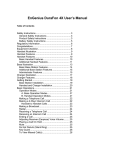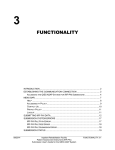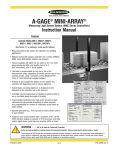Download 20 - aanac
Transcript
LTC LEADER FEB 20 2013 W W W. A A N AC .O R G Quadriplegia vs. Functional Quadriplegia: CMS Tackles MDS Coding Taking Threats of Self-Harm Seriously Betty Frandsen, rn, nha, mha, c-ne A study reported by Arizona State University School of Caralyn Davis, AANAC Staff Writer Officials with the Centers for Medicare and Medicaid Services (CMS) discussed several key issues at the Feb. 14 Skilled Nursing Facility/Long-term Care Open Door Forum. These include: MDS coding of quadriplegia CMS received an inquiry asking whether the diagnosis of functional quadriplegia could be coded in MDS 3.0 item I5100 (quadriplegia). The diagnoses listed in Section I (Active Diagnoses in the Last 7 Days) of the MDS 3.0 represent “active diagnoses that reflect a resident’s current functional, cognitive, mood or behavioral status; medical treatment; nursing monitoring; or risk of death,” said officials. “The diagnoses are listed by major category and are ones that are most problematic in the long-term care population.” In addition, the diagnoses listed in Section I “refer to a physician-documented diagnosis that is based on his or her clinical assessment and judgment,” they explained. “For those of you that are unclear, a physician-documented diagnosis also includes diagnoses that are documented by a nurse practitioner, physician assistant, or clinical nurse specialist only when allowable under state licensure laws. So it may vary by state.” There are many diagnoses that are not listed in items I0100 through I6500 of Section I, said officials. “It is not all-inclusive. This is for problematic diagnoses.” CMS has designated another item where other active diagnoses may be added: item I8000 (additional active diagnoses). For MDS coding purposes, item I5100 (quadriplegia) continued on page 2 Social Work (ASU) examined suicides in New York City nursing homes. Of the 47 recognized suicides, mean age was 76.2 years, 61.7% were males, and 68.1% were non-Hispanic white. The most common cause was a “long fall.” The study found that 42% had been placed in a nursing home during the year before their deaths, 33% reported pain, 33% had made a previous attempt, and 75% had a depressive syndrome. Thomas Magnuson, md, of the Division of Geriatric Psychiatry, University of Nebraska Medical Center, reports that risk factors include mood disorders, previous suicide attempts, alcohol abuse, male gender, physical decline or illness in self or spouse, and loss of social support. Staff turnover adds to risk when there is no continuity of caregivers who can identify changes. Depression may be unintentionally overlooked in nursing home residents and in their spouses who come to visit. Staff should become involved when a visiting spouse begins to look agitated, has lost weight, and seems overwhelmed. The Minimum Data Set (MDS) section D, “Mood,” assesses residents for thoughts of self-harm. Depression plays a key role, especially when it is unidentified and untreated. Staff need to be taught to recognize symptoms of depression, such as changes in eating and sleeping patterns, unexplained fatigue, indecisiveness, crying for no reason, an inability to be happy, behavioral changes, withdrawal from others, and a loss of interest in personal appearance. Depression may be unintentionally overlooked in nursing home residents and in their spouses who come to visit. Staff should become involved continued on page 3 CMS Tackles MDS Coding, continued from page 1 “primarily refers to the paralysis of all four limbs—arms, legs—caused by spinal cord injury, period,” stated officials. “Functional quadriplegia refers to complete immobility due to severe physical disability or frailty. Conditions such as cerebral palsy, stroke, pressure ulcers, contractures, advanced dementia, etc. can also cause people to have functional paralysis that may extend to all limbs, hence the diagnosis functional quadriplegia. “Individuals with these types of severe physical disabilities, where there is minimal ability for purposeful movement due to physical disability or frailty should have [their] primary physician-documented diagnosis coded on the MDS—and not the resultant paralysis or paresis from that condition,” they continued. CMSNet security changes On March 29, CMS will implement a security change that will impact CMSNet users, said officials. That raises the question: What exactly is CMSNet? Section 2, “Overview,” of the MDS 3.0 Provider User’s Guide explains the terminology: Under the umbrella of the QIES Assessment Submission and Processing (ASAP) system, the MDS 3.0 system “creates a standard, nationwide system for nursing homes and [swingbed] hospitals to submit MDS assessment data to a national repository.” With the MDS 3.0 system, facilities use “a secure, private intranet (CMSNet)” to electronically send files containing MDS assessment records to the National Submissions Database. Providers also use the MDS 3.0 system to access the CASPER With the MDS 3.0 system, facilities use “a secure, private intranet (CMSNet)” to electronically send files containing MDS assessment records to the National Submissions Database. Here’s an example: An individual with a diagnosis of cerebral palsy with spastic quadriplegia “would simply be coded under the cerebral palsy item, I4400,” said officials. “Lastly, for facilities wishing to capture active physiciandocumented diagnoses of functional quadriplegia, the appropriate place to code this on the MDS is in item I8000 by entering the ICD code in the spaces provided.” This clarification represents “current policy at this time,” stressed officials. “It has not changed.” One ODF caller pointed out that there is no definition of quadriplegia in the current Section I coding instructions. Consequently, her facility has been using the definition from the 2.0 RAI Manual. That is not good practice, said CMS officials. “You should not be using MDS 2.0 for anything at this point.” (Certification and Survey Provider Enhanced Reports) reporting application, according to Chapter 2, “Functionality,” of the CASPER Reporting User’s Guide for MDS Providers. The March 29 security change to CMSNet “basically will not allow users to access the Internet, your network printers, or your network folders while connected to CMS via CMSNet,” pointed out CMS officials. The QIES Technical Support Office (QTSO) has posted a workaround document detailing exactly how facility computers will be affected and offering workaround steps. “Users who are interested in retaining the ability to access their network printers or folders might want to look for a CMSapproved vendor who might be able to provide this service,” said officials. “You will need to contact those gateway service providers to determine if they will be able to meet your needs or not. SNF therapy payments research CMS has contracted with Acumen LLC and the Brookings Institution “to identify some potential alternatives to the existing methodology used to pay for therapy services in the skilled nursing facility prospective payment system (SNF PPS),” said officials. “We are currently in the very early stages of the project. Right now we are conducting a literature search and stakeholder outreach campaign for identifying and cataloging all of the alternatives to consider in designing a new payment system for therapy in SNFs.” CMS has set up an e-mail box, [email protected], so providers and other stakeholders can send “suggestions, comments, and feedback on what you would like to see us look at in the way of SNF therapy payment in the future for SNF PPS,” said officials. Providers shouldn’t dally making their voices heard. “We are looking at having those ideas and suggestions all compiled no later than next fall sometime,” said officials. “Then we are going to start on the next phase of the project, which is narrowing down the ideas and suggestions that we’ve received and really identify which ideas we want to look more closely at.” In total, the project likely will be “a few years in duration,” they added. As the project goes forward, CMS will post information on the SNF Therapy Payments Research website. RAI Manual update A spring update to the RAI User’s Manual for the MDS 3.0 is around the corner, said officials. Toward the end of April, CMS will post a private preview copy of the RAI Manual update on the QTSO website for the state RAI coordinators to review. CMS anticipates that the public release of the updated manual will occur in early May on the MDS 3.0 RAI Manual website. continued on page 7 2 aanac.org | 800.768.1880 A A N AC LT C L E A D E R 0 2 . 2 0 . 2 013 © 2013 AANAC. No part of this publication may be reproduced without written permission from AANAC. The information presented is informative and does not constitute direct legal or regulatory advice. Taking Threats of Self-Harm Seriously, continued from page 1 when a visiting spouse begins to look agitated, has lost weight, and seems overwhelmed. Incidents do occur in which a spouse from the community enters a facility and takes the life of the resident, then commits suicide. It is not out of line, if changes are noticed in the visiting spouse, to say, “Is everything all right? I am concerned about you.” Offer assistance from the social services department or a consult with the resident’s physician, or reach out to other family members. These actions may avert a tragedy. Suicidal behaviors fall into two categories. Direct behaviors include wrist slashing, jumping, hanging, smothering, gunshot, and overdose. Indirect behaviors include refusing to eat or drink, refusing medications, and refusing to follow medication directives. The indirect behaviors may be misinterpreted or unidentified. According to the ASU study, statements such as “I won’t need this anymore,” “I can’t take it anymore,” “Everything will be over soon,” “You will be better off without me,” and “I wish I were dead” must be taken seriously. Consider the following examples, which include direct and indirect selfdestructive behaviors, and see how many you can identify: Resident A’s MDS documented her thoughts of being better off dead. One evening she tied a shoelace around her neck for several minutes because she was depressed about life, then notified staff. A red mark was noted on her neck. She was sent to the hospital for a psych evaluation, but returned at 3 a.m. Room searches were conducted each shift for items she might use to harm herself. 3 aanac.org | 800.768.1880 When checked by a surveyor, her room contained five bras, two bags with 12inch fabric string handles, a bag with paper string handles, and a cloth bag with thick fabric handles—all items she could use to repeat her suicide attempt. A checklist instructed staff to look for food, cigarette butts, sharp objects, metal, glass, and utensils, but did not include risk factors for Resident A. An Immediate Jeopardy citation was issued by the Department of Health because “the facility did not ensure that the residents’ environment remained free of accident hazards. Specifically, a resident with known history of suicidal ideation had hazardous items in her room.” Resident C used the pointed ends of safety pins and brooches to stick the skin on her left hand. A CNA care card directed nursing staff to remove sharp items immediately when found, yet the resident was allowed to keep possession of her brooches because they were her personal property. A Psychological Services note documented “decrease in function, agitation, attention seeking, aggression (verbal), inappropriate behavior, isolation/withdrawal, noncompliance with medical care, and easily annoyed/short tempered.” The resident stated over and over, “I hate it here.” A nurse’s note documented Resident C was picking at her hand with a pin on Always take residents’ comments seriously and train staff to avoid delay. It is our responsibility to remain alert and to immediately investigate any concerns. Resident B told her son twice that she wanted to slit her throat and die. She told staff, “I’m gonna kill myself,” and was placed on 15-minute checks for a few days. Over a period of three months she was verbally aggressive, cried often, was non-compliant, refused meals, and swore at staff. A psychiatric evaluation was completed, Xanax 0.5 mg was ordered, and eventually Haldol was added. She attempted to cut her wrist with a knife. She tried to take knives from other residents and the kitchen. She hid a butter knife under her lap blanket, and said she would cut her throat when a CNA discovered it. She was placed on 1:1 observation and sent to the emergency room. After returning, she scratched her arms and hands and made them bleed. The RN supervisor was not aware of the facility policy for suicide risk assessment and precautions, and did not notify the MD or DON or complete a risk assessment. The Department of Health issued an Immediate Jeopardy citation because “the facility did not provide adequate supervision of a resident with known suicidal ideation with attempts.” a brooch, and the nurse took the pin away. When the resident became upset and slapped the nurse across the face, the nurse gave the pin back. The facility was cited at an Immediate Jeopardy level because it “did not remove items (brooches/ pins) which had the potential to injure residents.” An interdisciplinary team effort is required in order to protect residents from self-harm. Develop policies and procedures to guide the process when a resident expresses a wish to harm self, and ensure the protocols are followed. Educate staff so they respond quickly and appropriately. Individualize responses based on the specific resident and situation. Utilize MDS section D, “Mood,” and reassess as often as needed. Always take residents’ comments seriously and train staff to avoid delay. It is our responsibility to remain alert and to immediately investigate any concerns. Our residents’ lives may depend on it. ● A A N AC LT C L E A D E R 0 2 . 2 0 . 2 013 © 2013 AANAC. No part of this publication may be reproduced without written permission from AANAC. The information presented is informative and does not constitute direct legal or regulatory advice. MDS HAS A ROLE IN SUPPORTING SURVEY DEFICIENCIES Providers Can Use It to Improve Quality By Rena R. Shephard, mha, rn, rac-mt, c-ne RRS Healthcare Consulting Services This is a problem: The interdisciplinary team got its wires crossed and completely missed a Quarterly MDS assessment that should have had an ARD no later than six weeks ago. In compliance with MDS rules, the team set the ARD immediately for the current date and completed the late assessment. Team members commented that they hoped they wouldn’t get a deficiency for a late assessment when survey time rolled around. While such a deficiency certainly is a possibility, surveyors also can pick up critical information related to the resident’s quality of care and quality of life from an MDS. In this case, for example, the delay in the assessment caused the surveyors to focus in on the time frame in which the assessment should have been completed. They noted that the lookback would have captured significant new functional decline and a new onset of urinary incontinence that already had continued for three weeks. Thus, a Significant Change in Status Assessment (SCSA) would have been required instead of the Quarterly. Since the SCSA was not completed timely, the Care Area Assessments did not trigger; further, more in-depth assessment was not completed; and the care plan was not updated. The chart 4 aanac.org | 800.768.1880 revealed that about two weeks after the SCSA would have been completed, the resident got out of bed unassisted to go to bathroom, dripped urine and slipped on it, fracturing a hip and a shoulder. The deficiencies the facility received were much more significant than a late assessment. Speaking of falls: When investigating a fall, which is a significant Quality of Care issue, valuable information about risk can come from the MDS, whether it’s the facility or a surveyor looking at the incident. And proactively, problems in any of the following areas may be a red flag for risk for falls: •ADLs (G0110) •Balance (G0300) •Wandering (E1000) •S/S of delirium (C1300) •Antianxiety (N0410B) and Antidepressant (N0410C) •Fall since admission or prior assessment (whichever is most recent) (J1800) When a surveyor investigates a fall, these items are a good place to start to determine whether the MDS contained red flags that the facility missed. Here’s another example of how the MDS can identify or support survey deficiencies: You are the staff member assigned to complete MDS item B0200, Hearing. You’ve followed all of the instructions in the RAI User’s Manual for collecting relevant information. As a result, you enter the code 2 on the MDS indicating moderate difficulty. You are confident that you’ve arrived at the correct coding decision, and you feel sure that any auditor, such as a surveyor or a consultant, would agree that this is an accurate assessment. But, while the accuracy of the coding decision is supported by the chart, this code displayed on the MDS potentially has additional meaning for the surveyor ore other auditor— it is a spotlight on a problem that can have significant quality of care (QOC) and quality of life (QOL) implications for the resident. Hearing deficits can result in depression, boredom, and social isolation; the mismatch between communication with the resident and the resident’s responses may be misinterpreted as cognitive impairment; the resident’s preferences might not be adequately identified and honored. Nursing home providers who look at the MDS through the lens of Quality of Care and Life, as illustrated by the examples above, can go a long way toward preventing problems before they occur. This is just a small sample of Rena’s extensive knowledge on this topic. Join us, and Rena, at the 2013 AANAC Annual Conference and Exhibition where she will share her expertise on the ACA and its mandate for Corporate Compliance; the shattering effects of functional decline on health, dignity, and choice; and a deeper look at how the MDS can provide the necessary evidence to spotlight quality of care and life deficiencies like those outlined in this article. Visit www.AANAC.org/2013Conference for more information. ● A A N AC LT C L E A D E R 0 2 . 2 0 . 2 013 © 2013 AANAC. No part of this publication may be reproduced without written permission from AANAC. The information presented is informative and does not constitute direct legal or regulatory advice. Q+A The resident sits on the floor to watch TV. Is this a fall? Maybe someone could help me with this issue we are having. We have a resident on our Dementia Unit who is independent with ambulation and can understand most questions and directions. Per family and resident he has a long history of watching TV sitting on the floor in front of the TV. He is continuing this here and has been observed by staff to sit down on the floor safely and stand up safely when finished. We don’t want to do on-going incident reports for falls if found on the floor in front of the TV. My question is would it be appropriate to care plan the resident choice to sit on floor to watch TV as long as he is safe to do so and not complete fall reports? We would of course follow up as a fall if found on the floor other than in front of the TV….Deb F280 Right to Participate in Care Planning and Revision states “The resident has the right to—unless adjudged incompetent or otherwise found to be incapacitated under the laws of the State, participate in planning care and treatment or changes in care and treatment.” The CMS intent for this regulation is that a resident should, to the extent practicable, be consulted on personal preferences. There are two components to resident participation in development of care plan interventions: ensuring the resident can exercise his rights, and the facility’s responsibility for the resident’s health and safety. F280 cautions that while a facility should encourage residents and family members to make their individual choices known, the regulation does not create the right for the resident or family to demand that the facility follow their wishes if the choice is deemed to be inappropriate. Statutory requirements hold the facility Care planning decisions should be made by the interdisciplinary team, which includes the resident and/or his family and the physician...Take other residents’ safety and rights into consideration as well. The LTC Network Digest thread for this question included this helpful comment: Amber wrote: I would care plan this for sure. This way it communicates to staff and anyone else reading the care plan that this is what the patient prefers and you are providing patient-centered care. Since he has dementia, and this is a progressive disease, you may want to think about on-going safety assessments. Does he have a roommate? If so, does it affect the roommate’s safety? accountable for the resident’s safety. Care planning decisions should be made by the interdisciplinary team, which includes the resident and/or his family and the physician. Include the therapy department in the assessment process to determine that this resident can safely sit on and arise from the floor, as has been his past TV watching habit. Reassess his ability with the care planning cycle, or more often if his ability declines with potential to impact his safety. As Amber suggested, take other residents’ safety and rights into consideration as well. Please explain what “Provider Liability” means? Today I listened to an audio conference. The speaker was talking about the "provider liability” risk if the scheduled assessment is completed alone on Day 7 of the COT window. If the resident discharges before the scheduled assessment becomes "used for payment" the facility cannot bill Medicare for the days covered by the COT up to the discharge date. I don't know what this means. Can someone give me an example to explain? Thanks. Sure. Here is an example: Only an assessment 'used for payment' can negate or reset a COT. The COT was due on day 28 of resident's stay. The provider decides to complete 30-day assessment only using an ARD of day 27. The 30-day assessment would begin payment on day 31. This would negate need to complete the COT. Then the resident is discharged to the hospital on day 30. Since the resident discharged before the 30-day assessment was "used for payment" the 30-day assessment would no longer qualify as an assessment to negate the COT that was required on day 28. Since the resident was already discharged, it would be too late to complete the required COT and the provider would now have a missed assessment. The provider would end up having to take provider liability, meaning no payment, for the days associated with the missed COT, which would be days 22 – 29. Ronald A. Orth, rn, nha, cpc, rac-mt ([email protected]) continued on page 6 Betty Frandsen, rn, nha, mha, c-ne ([email protected]) 5 aanac.org | 800.768.1880 A A N AC LT C L E A D E R 0 2 . 2 0 . 2 013 © 2013 AANAC. No part of this publication may be reproduced without written permission from AANAC. The information presented is informative and does not constitute direct legal or regulatory advice. Q + A, continued from page 5 Please help! I have an urgent question about inactivating an MDS for wrong entry date? I have a PPS 5-day MDS that has the incorrect entry date. I am finding conflicting information as to inactivating. I also have an incorrect entry date on the Entry Tracking Form and I understand this has to be inactivated and I’ve done that. My question comes regarding the actual assessment, not the entry tracking form. 1. In the errata of 4/1/2012 (v1.08) on page 50, Inactivation Request in paragraph #1 it clearly states that you inactivate the entry tracking form when the admission date is incorrect. But in paragraph #3 is where the confusion comes in. I understand that they are referring to the items identified in paragraph #1 as the reasons to inactive but it could be taken to mean you have to inactive the assessment. 2. In the MDS 3.0 Manual latest version with effective items for 4/1/12, starting on 5-10 in the Modification Request section under 'exceptions' which goes on to page 5-11, at the bottom of 5-11 is the date April, 2012, in the first paragraph of 5-12 INACTIVATION REQUESTS I understand it to mean if there is an error in entry date, do a modification on the assessment but only inactivation on the entry tracking form. 3. On the SNF PPS Clarification Memo from CMS of March 29, 2012—page #8 under #8 Clarification regarding inactivation assessment, in the middle of the page it clearly lists those subset of items that may not be modified, again listing Entry Date (A1600) on an entry tracking record as one you must inactive. No mention that you have to inactive an assessment with this error. 6 aanac.org | 800.768.1880 So, here is the question, I oversee several MDS Coordinators for our company and want to ensure I understand correctly the inactivation rules. Am I correct in saying I do not do an inactivation of the assessment, just do a modification, correcting the entry date and not needing to use the date we identified the error as it is a modification AND we do need to do an inactivation of the Entry Tracking Form to correct the entry date there (and yes these assessment and entry tracking forms have been transmitted to QIES)? If the entry date on an ENTRY TRACKING record in incorrect, the ENTRY TRACKING form must be INACTIVATED. A new entry tracking form must then be completed with the correct entry date and transmitted. IF the ENTRY DATE on any MDS ASSESSMENT is incorrect, a modification of field A1600 is allowable. An incorrect entry date on an MDS ASSESSMENT does not require inactivation. Carol Maher, rn-bc, rac-mt ([email protected]) Expedited review and Denial Notices—what’s the difference? I have State surveyors here and need some Medicare advice. It has always been my practice to issue the standard denial letter for Medicare A, when skilled therapy is done and the resident is discharging to home. Surveyor told me that I should also issue the Expedited appeal form with the Denial letter. I issue standard denial letter for Medicare A services when resident wants to go to Hospice also. I do not issue the Expedited appeal form. Have I been doing this wrong all this time? Should I be issuing an Expedited appeal form for ALL Medicare A denials? I would really appreciate an answer to this question for Surveyor. Help!!!! Thanks. These requirements can be confusing. Here is a summary of them. The Notice of Medicare Non-Coverage (NOMNC), also known as the expedited review allows a resident the option of appealing the providers decision to end skilled Medicare coverage regardless of whether the resident is staying in the facility or not. This is the form that instructs the resident to contact the State's Quality Improvement Organization (QIO). See the link and info below. The NOMNC requirement is a separate requirement from (or in addition to) the Advanced Beneficiary Notice (ABN)/Denial Letter process, which is required when a resident is coming off Medicare A and will become liable for their expenses in the facility after a certain date and it offers the resident the right of appeal via the demand bill process to the FI/MAC. http://www.cms.gov/Medicare/MedicareGeneral-Information/BNI/downloads/ UPDATED_InstructionsforNOMNC.pdf When to Deliver the NOMNC A Medicare provider or health plan must give an advance, completed copy of the Notice of Medicare Non-Coverage (NOMNC) to beneficiaries/enrollees receiving skilled nursing, home health, comprehensive outpatient rehabilitation facility, and hospice services not later than two days before the termination of services. This notice fulfills the requirement at 42 CFR @405.1200(b) (1) and (2) and 42 CRF 422.624(b)(1) and (2). In situations where the termination decision is not delegated to a provider by a health plan, the plan must provide the service termination date to the provider not later than two days before the termination of services for timely delivery to occur. Judi Kulus, nha, rn, mat, rac-mt, c-ne ([email protected]) ● A A N AC LT C L E A D E R 0 2 . 2 0 . 2 013 © 2013 AANAC. No part of this publication may be reproduced without written permission from AANAC. The information presented is informative and does not constitute direct legal or regulatory advice. CMS Tackles MDS Coding, continued from page 2 AANAC Board of Directors Ruth Minnema rn, ma, c-ne, rac-ct Chair Peter Arbuthnot aa, ba, rac- ct Vice Chair Carol Maher rn-bc, rac- ct Secretary Patrice Macken mba, rhia, lnha, rac- ct Treasurer Susan Duong rn, bsn, nha, rac- ct, c-ne Gail Harris rn, bsn, rac- ct, c-ne Joanne Powell nha, rhia Carol Siem msn, rn, bc, gnp, rac- ct Diana Sturdevant ms, gcns-bc AANAC Expert Panel AANAC is pleased to introduce you to our panel of volunteer reviewers who represent the best and the brightest in our field: Betty Frandsen rn, nha, mha, c-ne Nichols, NY Robin L. Hillier cpa, stna, lnha, rac-mt President, RLH Consulting Becky LaBarge rn, rac-mt Vice President, Clinical Reimbursement The Tutera Group Deb Myhre rn, c-ne, rac-mt Nurse Consultant, Continuum Health Care Services Ron Orth rn, nha, rac-mt Clinical Reimbursement Solutions, LLC, Milwaukee, WI Andrea Otis-Higgins rn, mlnha , cdona , clnc, rac-mt CEO, Administrator, St. Andre Healthcare Biddeford, ME Rena R. Shephard mha, rn, rac-mt, c-ne AANAC Executive Editor President, RRS Healthcare, Consulting Services, San Diego, CA Judy Wilhide Brandt rn, rac-mt, c-ne Regional MDS/Medicare Consultant President, Judy Wilhide MDS Consulting, Inc. All the articles in this LTC Leader can also be found on the aanac.org website. 7 aanac.org | 800.768.1880 MDS 3.0 data specs As a reminder, updated MDS data submission specifications (V1.12.0) will be implemented on May 19. In addition, updated data specs (V1.13.0), as well as updated MDS item sets, also will be implemented on Oct. 1. The October data specs and item sets are currently in draft format, stressed officials. “There may be changes. Until that date, do not consider it final.” This information is maintained on the MDS 3.0 Technical Information webpage. Note: Providers likely should anticipate a fall RAI Manual update to coincide with the pending Oct. 1 changes to the data specs and item sets. Manual correction change? Section 5.8, Special Manual Record Correction Request, in Chapter 5, “Submission and Correction of the MDS Assessments,” of the RAI Manual currently indicates that an MDS record that “has the wrong submission requirement in item A0410” must be corrected with a Manual Assessment Correction Request. However, in response to multiple ODF callers who asked what is the correct procedure to remove assessments completed for Medicare Advantage residents that incorrectly have been submitted and accepted by CMS, agency officials said that those assessments should be inactivated. “At this point, …inactivate,” they stated. “However, for several years now we have been telling you not to submit those. We will work internally and with the various states to determine the best process moving forward.” Jimmo v. Sebelius On Jan. 24, the agreement between CMS and the plaintiffs was finalized for Jimmo v. Sebelius, the “Improvement Standard” case that addresses the issue of skilled maintenance nursing and therapy. “We have one year from the approval date, which was Jan. 24, to do manual revisions and an educational campaign for both contractors and providers and the general public,” said officials. “We are starting to get those implementation things moving in line, but we don’t have anything to specifically tell you at this moment.” (The Center for Medicare Advocacy, one of the plaintiffs in the case, maintains a webpage with the most up-to-date information about the settlement.) Facility RUG codes don’t match QIES ASAP An ODF caller asked how to handle a situation where the Final Validation Report indicates warning error 3616a: “The submitted value of the HIPPS/RUG code does not match the value calculated by the QIES ASAP System.” Section 30.1, HIPPS Code, of Chapter 6, “SNF Inpatient Part A Billing and SNF Consolidated Billing,” of the Medicare Claims Processing Manual offers a clear answer: “When such discrepancies occur, the RUG code reported on the Final Validation Report shall be used for billing purposes.” However, if consultation with the facility’s software vendor doesn’t solve the problem on the front end and the facility believes that that the HIPPS code that was calculated by the ASAP system is incorrect, “please submit an e-mail to [email protected],” advised officials. Editor’s note: The next ODF is scheduled for March 21. Questions can be sent to SNF_ [email protected]. ● A A N AC LT C L E A D E R 0 2 . 2 0 . 2 013 © 2013 AANAC. No part of this publication may be reproduced without written permission from AANAC. The information presented is informative and does not constitute direct legal or regulatory advice.








